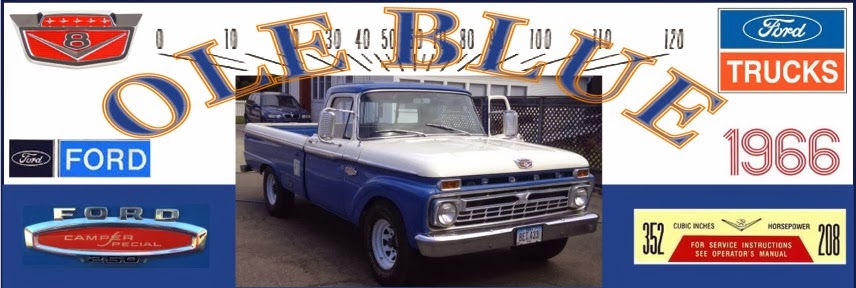Everybody and their grandmother has a trick to treating rust in old cars. There seems to be a couple of different ways people approach the problem of rust on floor pans, dashboard elements, vent covers, mirrors, etc. Floor Pans are a science unto themselves and usually result in complete replacement by cutting out old and welding in new and prepping with various sealants to protect the new metal. I do not want to go that far with Old Blue this week, but rather would like to get an idea as to how much rust has eaten through the pans and maybe stop or retard the process if possible. I do want to remove any rust on the various metal components in the cab and treat and repaint if possible to give the cab a bit of a facelift.
Many, many articles exist on the web describing what others have done to manage rust in their old vehicles. Some are product specific and I tended to stay away from those, focusing instead on the blogs and Q&A forums describing recommendations and successful processes for refreshing cab elements.
The most complete process I have found basically strips all paint and rust from the metal; treating the bare metal with an epoxy sealant to retard future rust, prep with sandable primer to fill in any issues with the surface then add a color coat using either 1-stage (color and clear coat in one) or 2-stage (color and clear coat separate). For the small bits in the cab I will use what they call the 'Rattle Can' paint source because I do not have a compressor or the desire (for these small parts) to buy paint in bulk.
The first step after removal of the pieces from the cab is to get the old paint and rust off the parts. Each part had to be examined and looked at as some had plastic parts attached (the vent handles) and others I did not want to repaint because the color is so unique and I could not find a good indication as to what color I could use to refresh the piece (the review mirror on Old Blue is NOT argent like other components or White but instead some kind of pale pinkish /white color unknown to me).
I removed the air vent doors;I have never painted automotive metal before and was a little unsure of the REAL process - it always seemed so magic the way bared metal becomes shiny, glossy, rich looking surface. I had some experience with my bicycles as a kid and knew I didn't have a clue how to get the professional quality results I wanted for Old Blue, though would settle for something just eye appealing.
The vent doors were originally a semigloss black but were now dirty, rusty and held in place against the kick panels by five rusty hex screws. It took some effort to get the screws out, two were stripped and all required positioning my hands in an awkward way to remove. I used a small 1/8" rachet with the help of a flat head screw driver and a crescent wrench to remove the two air vents under the dash.
The screws are rusted as well as the front and back of the cover itself.I gave each screw a squirt with WD-40, tapped each screw 3 times (to let Old Blue know I needed the screw or bolt !) and removed the piece.

For these pieces I will selectively strip old paint, apply rust treatment, and repaint. The screws will be treated similarly. I wanted to take care not to damage the plastic frames but definitely wanted to clean them up and make them shiny black as well.
There are a number of products on the market to remove rust. I looked at the various scrubbers (sand paper/wire brushes), acids (Muriatic/Phosphoric) and blasters (Sand/Glass Bed). All seem to have well documented pros and cons and for this first effort I decided:
- Sand Blast off old paint
- Use Phosphoric Acid to remove rust
- Prime and paint
I chose to sand blast because I did not want to use a chemical stripper and I could get a small setup from Harbor Freight for about half the cost of sending the pieces to the local shop. I starting planning the purchase of the compressor, the tube, the blaster, the media (sand!) and protective gear (Jumpsuit, face mask, goggles).
While I wait for the next weekend's sale at Harbor Freight I will try the best known phosphoric acid product known - naval jelly. The screws holding the vents to the kick panel are rusted blobs so I dropped them into a small pool of naval jelly I picked up at Orchard Supply. This brand is phosphoric acid of some unknown dilution but i follow the instructions and for this application it works well.
 |
| Vent nuts in Naval Jelly |
I let them sit in this juice for an hour and then rinsed well with water per the instructions on the label. The result was better than expected and showed that the original nuts were actually black.
In preparation of my compressor purchase I researched the size and most importantly something called the CFM capacity of various units at HF. For the small pieces I wanted to blast I would need at least a 10 gallon tank with 120 PSI.
With the standard 25% off coupon available all over the web and a managers weekend sale (On sunday all open box compressors are an additional 50% off!) I was able to get the complete setup for under $150.






































